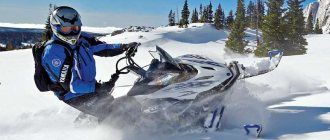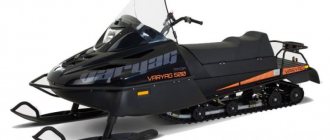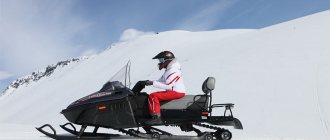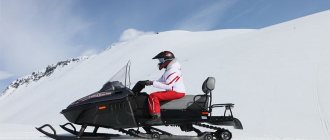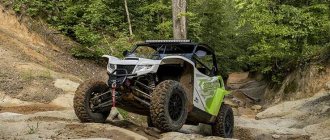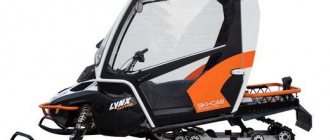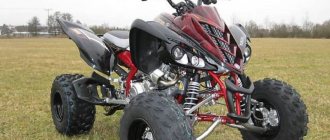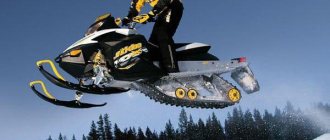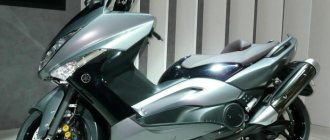When releasing a new model onto the market, especially if it is a replacement for an older version, engineers try to show it before the predecessor leaves, or, in extreme cases, after a short period of time.
But the XVS400 Drag Star - 400 from Yamaxa was waited for two years. Virago 400 - went down in history in 1994.
A replacement was born only in 1996 . The model lived on the assembly line for 21 years (until 2021), had only one forced modification and remained virtually unchanged throughout the entire production period.
Specifications
The lack of liquid cooling on the engine makes long trips in hot weather not entirely comfortable.
With the exception of the injector, there were no other innovations in the engine. It was a 2-cylinder, 4-stroke V-shaped engine:
- working volume - 399 cm3;
- power - 30 (after 2010), 33 (before 2009) hp;
- number of valves - 4;
- cylinders - 2;
- cooling - air;
- fuel supply - Mikuni carburetor (injector since 2009);
- ignition - transistor;
- start - electric starter;
- fuel tank - 15 l.
It is interesting that, unlike the usual scheme, where a button is used, you need to lightly give the gas after the start , otherwise the engine will immediately stall.
Transmission and clutch
The highlight of the model was the presence of a cardan.
The cardan transmission on the “Drag” is maintenance-free, one of the eternal ones.
- Users responded differently regarding the 5-speed gearbox , but they did not consider it a disadvantage. Some people were satisfied with the long gear shift, “turn it on and go.” Others wanted to click all 5 and not bother further (after all, there is no tachometer). But overall there were no complaints.
- clutch , oil bath .
Brakes
Front disc brakes.
Rear drum brake.
Despite the relatively long production of the model, the drum on the rear axle .
The front wheel immediately received 1 disc with 2 support pistons. Its diameter was 298 mm .
First race
In the very first race in Japan, the YA-1 motorcycle won and became famous throughout the country. After its brilliant debut in Japan, Yamaha turned its attention to the international market. Yamaha won a podium place at the US Grand Prix, Catalina, on its first attempt. Then the company decided to try its hand at the TT race on the Isle of Man, which was rightfully considered the most difficult in the world, and again took a podium place, declaring itself to the whole world. These successes allowed Yamaha to enter international markets ahead of other Japanese motorcycle manufacturers and became the company's first step towards globalizing its business. Yamaha began developing products with an eye toward markets around the world and focused on manufacturing technologies that would ensure high quality products. Quite quickly, a conveyor production system was created, one of the iconic products of which was Japan's first sports motorcycle, the YDS-1. He debuted in 1959.
At the same time, Genichi Kawakami visited the United States and became acquainted with water sports popular among Americans. He decided to start promoting water recreation equipment in Japan. And already in 1960, Yamaha began producing boats with a composite plastic hull (CAT-21 and RUN-13) and outboard motors (P-7). The company's debut in the water technology sector was the first step towards business diversification.
In 1962, Yamaha undertook a major management overhaul to improve sales, strengthen the direction of advanced developments, and increase the enthusiasm of its rank-and-file employees. The measures taken allowed the company to continue its successful development. A number of high-profile successes in motorcycle racing in those years inspired engineers to new, even more ambitious developments. 1964 and 1965 Yamaha has won two consecutive manufacturer titles in the 250cc class of the World Road Racing Championship.
In 1964, the company developed Yamaha Autolube, an independent oil supply system for two-stroke engines. This technology gave the green light to a new generation of sports motorcycles and was highly appreciated by customers around the world.
In those years, Japan was entering an era of unprecedented economic growth, and Yamaha introduced several premium motorcycle models. In 1968, the 250DT-1 debuted, creating a new trial category, and in 1970, the XS-1 was Yamaha's first motorcycle with a 4-stroke engine. Also in the boating market, Yamaha introduced Japan's first fishing boats and work boats with composite plastic hulls. In response to growing market demands, the company has significantly increased its production of outboard motors, expanding both its product range and its applications around the world. At the same time, the 2000GT sports car was developed jointly with Toyota. The introduction of automobile and general purpose engines into Yamaha's production range embodied the company's commitment to business diversification. It was in 1968 that the company's first snowmobiles were born.
In the 1970s, the oil crisis triggered stricter emissions regulations and created an urgent need to save fuel. Yamaha responded with a range of innovative solutions. Consumer preferences have seriously changed: the priority now was not quantity, but quality. In response to these changes, Yamaha introduced the fuel-efficient Passol scooter, as well as a number of other new products created taking into account the diversity of customer preferences and lifestyles.
To develop the watercraft market, a special project team was created to develop a global sales strategy for outboard motors, taking into account the needs of local markets. Yamaha also developed diesel outboard engines of an original design.
In the world of racing, Yamaha continued to perform at the highest level and achieved outstanding success. Since 1978, Yamaha riders have won world championships three years in a row. In 1979, the Yamaha XT500 won the prestigious Paris-Dakar rally. By 1982, the total production of Yamaha motorcycles reached 20 million units.
During this period, Yamaha significantly expanded its presence in the global market. However, at the same time in Japan, the rapid growth of the motorcycle market resulted in fierce competition between manufacturers. The negative consequences of this situation led to a second serious crisis in Yamaha management. But in 1983, the company was headed by Hideto Eguchi. Under his leadership, the “New Yamaha” program was launched, designed to reorganize the management of the company. The main idea of the program was to encourage and implement the initiatives of ordinary employees - and after two years, these innovations led to an increase in the company’s revenues and profits. The high exchange rate of the Japanese yen and the subsequent recession in the Japanese economy affected many companies. However, Yamaha managed to avoid negative consequences by moving production abroad. The move also made Yamaha an even more global company.
This period is marked by new achievements. In 1984, Yamaha developed the world's first five-valve DOHC engine. The FZ-750 motorcycle equipped with this engine became a sensation both in Japan and abroad. In the field of water technology, the company actively developed the production of boats, as well as the production and export of outboard motors. In parallel with this, Yamaha began developing engines for racing cars for Formula 2, Formula 3000, and then Formula 1. Over the years, Yamaha all-terrain vehicles and ATVs have gained immense popularity in both recreational and commercial use. Yamaha entered the new water sports market, producing industrial robots, chip assembly equipment, heat pumps and air conditioners and agricultural unmanned helicopters, increasing the diversification of its business.
In the fall of 1990, there was a crisis in the Japanese stock market, which led to a sharp drop in stock prices and a collapse of the economy. To overcome the effects of a prolonged recession and expand the company's globalization, Yamaha announced a new corporate philosophy, setting a course for creating. In other words, Yamaha Motor's goal now is to bring more joy and happiness to people and create a Kando feeling in their lives - a feeling of joyful excitement and deep satisfaction. As a global company whose products are used on land, in water, in snowy fields and in the sky, Yamaha Motor has strived to “make the lives of people around the world more joyful and fulfilling”, applying all its skill and passion to to fulfill people's dreams and be the one they turn to for the "new Kando".
In 1994, the company was headed by a new president, Takehiko Hasegawa. He relied on careful monitoring of current customer needs. This period was marked by such achievements as the Majesty maxi-scooter and the Dragstar cruiser, which were distinguished by their striking design and high level of comfort. In motorcycle racing, the heavily modified YZR500 broke one record after another. Yamaha also set a record for the most victories in the Paris-Dakar rally. In the boating industry, Yamaha has become increasingly active in various competitions, including the most prestigious yacht races. The company continued to develop new products and conduct various promotional activities to attract more people to water sports. In 1995, the entry-level boat SRV debuted.
The Yamaha Z200N two-stroke outboard engine with the world's first high-pressure injection system and the record-breaking power-to-weight ratio F225 four-stroke engine have won multiple awards for their performance, low emissions and superior fuel economy.
In the early 90s, Yamaha also developed several completely unique products. For example, artificial underwater reefs to increase fish populations and the world's first electric hybrid bicycle. For people with disabilities, Yamaha has developed electric power assist for manual wheelchairs.
In 2001, when the Japanese economy was still in recession, a new president, Toru Hasegawa, took the helm of Yamaha. Under his leadership, the company focused on developing new products using Yamaha's unique technologies in order to stand out from the competition not just in words but in deeds.
These products included the TMAX Automatic Super Sports maxi scooter and the MT-01 muscle bike category. During the development of these products, Yamaha created fundamentally new core technologies, including new aluminum alloy casting technology and fuel injection systems for four-stroke engines.
At the same time, for the rapidly growing Asian markets, Yamaha prepared a special brand communication strategy and developed several models specifically for the Pacific region, and also strengthened its production capabilities in Asia. In racing, Yamaha won three championship titles in the prestigious MotoGP world championship: victories were won in the manufacturers', teams' and riders' championships. In the World Motocross Championship, Yamaha won the individual and manufacturers' titles.
In the world of boating, Yamaha has taken a leading position in the production of outboard motors for both commercial and recreational use, winning the sympathy of customers around the world. The Yamaha Swim 21 was the first pool with a composite plastic bowl approved for the World Swimming Championships. Yamaha has established itself as a leading swimming pool manufacturer.
In the area of environmental protection, Yamaha has opened new lines of business and created products with fundamentally new capabilities. So in 2002, the company entered the biotechnology market with solutions for CO2 absorption and sequestration. 2003 saw the debut of the Passol electric scooter and the FC06 fuel cell scooter. The following year, they introduced an autonomous navigation system for automated surveillance systems. In 2005, the company celebrated its 50th anniversary, which was celebrated around the world. Yamaha Motor Co. was headed by Takashi Kajikawa, who continued the process of globalization of the holding. As part of its growth strategy in the Asian market, the company opened a new motorcycle plant and global training center in Indonesia. Yamaha was also actively expanding its presence in the BRIC markets of Brazil, Russia, India and China, which had good growth potential. In these markets, Yamaha not only sold its products, but also participated in the organization of leisure infrastructure, and also supported children's sports events. These initiatives resulted in a significant increase in sales figures, which reached record levels. For example, in 2007, the total production volume at factories in Indonesia reached 10 million motorcycles. However, at the same time, the company also faced losses due to the outbreak of the global financial crisis and the global economic recession. Despite a series of unfavorable events, Yamaha bravely and decisively accepted the next challenge of fate. In 2009, Tsuneji Togami became the head of the company, and a new stage began in the history of Yamaha. Recovery from the financial crisis required structural reforms and new growth strategies. Yamaha has reorganized production systems at factories in and outside Japan, and several new products have been introduced into Asian markets. These efforts yielded results within a year, and the company became profitable again. Opening up new promising market segments, the company introduced the EC-03 electric scooter. In collaboration with Toyota, the concept of a communication system for personal vehicles of the future was developed.
The threat of instability due to the high value of the Japanese yen was successfully overcome by establishing the highest standards of production and training at a global level. A design center was also created to strengthen Yamaha's design school. Supporting a variety of cultural and sporting events has become an important element of Kando's philosophy and has contributed significantly to raising the profile of the Yamaha brand. In 2010, the company returned to profitability and celebrated 50 years in the boating industry with the introduction of several new boats and outboard motors. In MotoGP, Yamaha achieved triple victory in the individual, team and manufacturers' championships for the first time in the history of the championship for three years in a row. 2011 marked another memorable achievement, marking Yamaha's 50th year in the World Championship. In 2013, Yamaha unveiled a new medium-term business plan to achieve sustainable growth and sustainable development for the company. The new challenge was enthusiastically accepted by the company. Yamaha does not intend to rest on its laurels. The company is focused on the future and is tirelessly moving forward towards ever more ambitious goals. After all, this is precisely the unique spirit of Yamaha. To provide people around the world with more enjoyable experiences and help them achieve their self-realization, Yamaha continuously strives for excellence to be . Each new product brings our customers a feeling of joyful excitement and deep satisfaction.
Driving performance
The running parameters did not stand out in any way for a cruiser.
The maximum declared speed is 135 km/h.
Yamaha Drag Star 400 is a cruiser with an optimal engine capacity and economical fuel consumption.
According to users, you can safely push both 140 km/h and 150 km/h. There seems to be little power, but nevertheless it is enough.
Acceleration to hundreds
Acceleration from zero to 100 km/h in 10 seconds . (In some publications it is less) but according to users - 12 seconds .
Fuel consumption
consumption is 2.5 liters per 100 km. On Russian roads - up to 5 liters.
Owner reviews
The Yamaha YZF R1 is the choice of those who do not succumb to the provocative nature of the liter “iron horse”, but at the same time create a wonderful tandem with it on the track or highway. Most Russian owners drive early versions, which are not inferior to new products in city mode or traveling short distances.
In general, the Erka is rated as well-controlled and safe, but if you are a beginner, these qualities will be difficult to recognize behind the instant power gain and sharpness of movements.
The expectations of motorcyclists who switched to this sport are fully justified, because they receive:
- An indescribable feeling of freedom, coolness and prestige.
- Recognizable engine noise and coordinated operation of all components.
- Crazy dynamics and excellent maneuverability.
It has been compared to a Ferrari, an airplane and a rocket, it provokes a constant rush of adrenaline, and you won’t want to hide its design in the garage. Are you ready for this technology to appear in your life? Then immediately choose your R1.
Modifications
Since the bike looks, and is essentially, a classic chopper, not all buyers liked this look.
Despite the great resemblance to a Harley, like Terminator 2, they didn’t want to buy one for themselves. It was taking care of these that in 1998, the developers introduced the Yamaha Drag Star 400 Classic .
On the Classic version, wider fenders are striking.
The rear light is another visible difference.
It did not have a chopper fit, and besides this, it had different fenders, head optics, a different saddle and handlebars. The front wheel has also been reduced in size. Some parts of the body kit have changed. The filling remained the same. Until 2021, both models were assembled in parallel.
Dimensions and weight
The parameters of the Classic model differed upward in almost all respects.
Dry weight: 204-209 kg. For modification 220–224 kg.
Curb from 220 to 234. Classic from 238 to 247.
Dimensions (size ranges for modification in brackets):
- the length of the bike has not changed - 2340 (2450) mm ;
- the width has lost weight, but the Classic has not: from 845 to 840 (930) mm ;
- Both grew in height: from 1045 to 1065. (1105-1110) mm;
The height of the saddle has also changed: from 660 to 712 mm .
For whom is it intended?
Unlike the model that was designed for Japan (Drag Star 400), the increased saddle height of the classic model (Drag Star 400 Classic) redirected the bike towards taller riders.
This four hundred is recommended for beginners or as a second motorcycle.
This is one of the reasons that used Zvezda from Japan is more often found in chopper form.
Appearance, distinctive features
YZF-R1 is easy to recognize and impossible to forget
The Japanese flagship has a comfortable horizontal fit, which is suitable for compact and tall bikers. It differs from its sporting counterparts in its wide wheels, the “flattened” shape of the muffler and the rather soft features of its “face”, reminiscent of the robot Wall-E from the cartoon of the same name. Smooth lines are perfectly emphasized by rich LED optics.
Available fairing colors:
- Black metallic,
- Matt gray
- Dark grey,
- White with a blue tint,
- Metallic blue,
- deep red,
- Yellow with a red tint,
- Bright red.
Having racing lines, the motorcycle looks harmonious in city traffic, attracting the attention of passers-by and drivers.
Competitors
Although the chopper market is a conservative market, other brands can be seen in motorcycles from Japan.
Suzuki Intruder 400 Classic.
Kawasaki VN400 Vulcan.
Honda Shadow 400.
- Suzuki Intruder 400 Classic cruiser offered the user liquid cooling. Produced from 2001 to 2016 .
- The Kawasaki VN400 Vulcan also offered fluid, and in the process of evolution began to install rear discs. But the “green” bikes had a conventional drive - a chain. Started production of the model in 1995 and finished in 2003.
- The Honda Shadow 400 offers coolant, and in 2009 it also launches a driveshaft. Production begins in 1997 and ends by 2021. It is worth noting that the Drag Star 400 Classic is a classic modification, and the Honda Shadow Classic is a chopper, only slightly different.
Story:
Yamaha is one of the oldest corporations in the world, founded in 1897 by entrepreneur Torakusu Yamaha. The history of Torakusu Yamaha's work with musical instruments began in 1887, when a man asked him, a medical instrument repairman who lived at that time in the city of Hamamatsu (Shizuoka Prefecture), to repair a reed organ (harmonium). Working with this instrument captivated him so much that after completing the repairs, he decided to create his own sample of a harmonium. Based on the knowledge of the structure of this musical instrument gained during the repair process, he began to handcraft every part. Two months later, he delivered the finished organ himself for testing to the Institute of Music Research in Tokyo (currently the Tokyo National University of Fine Arts and Music). The institute's specialists recognized that the instrument has the correct body shape, but identified a number of shortcomings, including instability of tuning. Not giving in to disappointment, Torakusu Yamaha decided to stay in Tokyo and achieve his goal by studying music theory and tuning techniques, becoming a special student at the Institute of Music Research. After a month of intensive study, Torakusu Yamaha returned to Hamamatsu, where he began to work from early morning until late evening, making his second reed organ. After re-inspection, his instrument was found “worthy of replacing imported analogues.”
Thorakusu Yamaha
These events took place in 1887, it was then that the master chose the vector of development of the future business. In 1889, Thorakusu Yamaha founded the Yamaha Organ Works company, and eight years later, in 1897, he created the Nippon Gakki company, whose symbol was tuning forks, and whose trademark was the figure of a Chinese phoenix with a tuning fork in its beak. In those same years, the company received its first order to export organs to Southeast Asia, and in 1900 it produced its first batch of pianos. In 1902, production of the first grand pianos under the Yamaha brand began, and in 1904, the organ and piano produced by the company received the Grand Prix at the World Exhibition in the American city of St. Louis. The company's successes in woodworking were also noted.
In 1914, Nippon Gakki began producing harmonicas under the Yamaha brand and began exporting in the same year. Success accompanied the company in all its endeavors. In 1921, the Japanese government decided to use Nippon Gakki's woodworking expertise to create aircraft propellers. In 1922, the production of high-quality phonographs began under the Yamaha brand, in 1930 the first acoustics analysis laboratory was founded, in 1932 the production of wind organs was mastered, and in 1941 the production of acoustic guitars began. The company knew how to quickly and effectively repurpose its production. Thus, metalworking technologies were in demand for casting frames for grand pianos and pianos, and later in the production of wind instruments.
After World War II, the owners of Nippon Gakki thought about reorienting the company to produce more in-demand products, such as modern motorized vehicles. The new direction of development was made possible thanks to the exclusively personal data of the new head of Yamaha, Genichi Kawakami. Ambitious goals and a creative approach - this is how this period in Yamaha’s history can be characterized.
Genichi was the eldest son of Kaichi Kawakami, the third president of the company. Genichi began working for the company in 1937 and soon headed one of its factories. He then became managing director and in 1950, at the age of 39, became the company's fourth president. Recalling the creation of Yamaha Motor, Genichi Kawakami said: “Although the company showed good results and had good financial indicators, I realized that we needed to find new areas of activity. I did some research to see what could be produced on the machines we had. So my thoughts came to motorcycles. Although we were a late entrant into this market, my head of research and other staff visited the country's leading motorcycle factories and convinced me that there was ample opportunity for development in this market. I didn't want to start this unfamiliar business without any preparation, so we went to the German motorcycle factories before starting to develop our first 125cc motorcycle."
After several years of preparation, the company released its first motorcycle, the YA-1. This small model, equipped with a single-cylinder 125 cc two-stroke engine, was called the “Red Dragonfly” and brought stunning success to its creators. The company's management decided in 1955 to found a subsidiary that began producing motorcycles - Yamaha Motor. Thus Yamaha Motor Co., Ltd. was born. led by founding president Genichi Kawakami.
Flaws
- The rear drum - what is there, what is not, even when adjusting the path, it is better to work with the front one. Landing allows.
- The suspension is not for Russia.
- Not suitable for long overtaking sessions.
and dignity
When creating the Drag Star 400, the Japanese aimed to make the model convenient for both long-distance and short-distance driving. We must give credit that they succeeded.
The bike has many advantages. Here are a few.
- Low center of gravity.
- Dynamics (for a cruiser).
- Eye-catching.
- Soft sofa.
